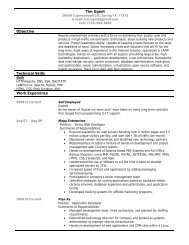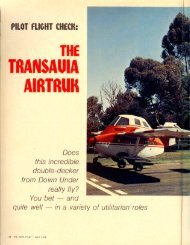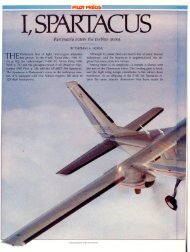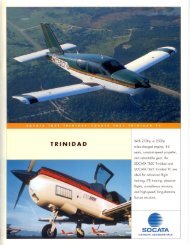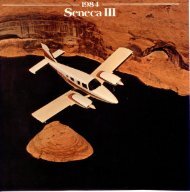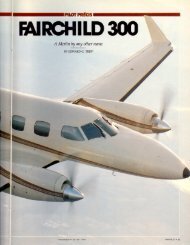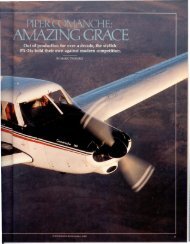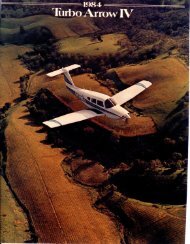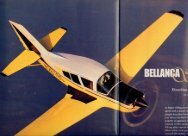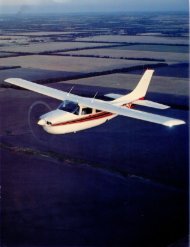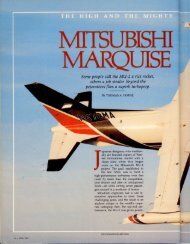Mooney 231 - Aero Resources Inc
Mooney 231 - Aero Resources Inc
Mooney 231 - Aero Resources Inc
- No tags were found...
You also want an ePaper? Increase the reach of your titles
YUMPU automatically turns print PDFs into web optimized ePapers that Google loves.
original performance increase, whichwas derived from the old Executive(the Model 201), was developedwithin very strict and modest budgetlimitations. In turn, its success providedmuch of the development capitalfor the Model <strong>231</strong>. Sure, thecompany is owned by Republic Steel,so one would assume budgets to begenerous if not enormous. But<strong>Mooney</strong> had to prove its ability tosurvive before Republic would providemuch funding beyond what wasessential to keep the doors open. Andresearch and development hasn't beenthe only division of <strong>Mooney</strong> (or anyother fIrm) requiring funds; the competitionamong departments can befIerce. By any measurement, <strong>Mooney</strong>has to be considered a success.We think that in achieving it asthey have-by demonstrating theability to increase performance efficiently-thecompany has pointed theway to go in the future. Energyavailability and cost alone may endthe perennial single- versus twin-engineargument for most pilots, exceptfor those with practically no operating-budgetlimitations.This year, <strong>Mooney</strong> has joinedBeech, Cessna and Piper in offeringadditional weather protection on itssingle-engine aircraft (although atthis writing Piper has not yet certificatedthe known icing package forthe Saratoga SP and Turbo SaratogaSP). Electric propeller deicing andRCA's digital Weather Scout I single-engineradar are now availableoptions on the <strong>Mooney</strong> aircraft.While this doesn't make the <strong>231</strong> ago-anytime airplane, the two optionsdo provide weather avoidance capability-anelectronic eye in thesoup-as well as protection for thekey element, the propulsion system,should one encounter unanticipatedicing conditions. To be able to flyduring forecast icing, a full-protectionsystem certificated for known icingis required. And there are conditionsin which even the best equippedairplane shouldn't go. However, theelectric propeller system extends theairplane's capability and the pilot'soptions duriT\g chance encounters.The first Pilot evaluation flights ofa <strong>231</strong> occurred last winter during aseries of cold, wet I FR systems.More time was logged IFR thanVFR, and there were several timeswhen unforecast icing conditionswere encountered. During one suchflight, we were convinced that the extra$5250 in base price between the201 and <strong>231</strong> was well worth it. Iceexisted virtually everywhere, exceptwhere it was forecast. We requestedaltitude changes and information severaltimes, attempting to stop the accumulation.The greatest concernwas getting an unbalanced load onthe propeller. Any ice on a propellercan be bad, since performance onmost aircraft is degraded far fasterthan with airframe ice. An imbalanceliterally can shake the propeller andengine so badly that the prop canfail, or the engine can be torn fromthe mounts so quickly that catastrophicfailure can occur before analert pilot can shut down the engine.Bless that turbo! We climbedthrough 17,000 feet before westopped taking on ice. Pilots of aircraftbelow us were in serious trouble-twotwins reported that theywere unable to climb and that theywere too low already to have anyhope of descending to get out of theicing conditions. It was one of thoscdays when the only hope was to goup-'way up.How much easier an electric propellerdeicing system (or alcohol)would have made the Hight that day,because there was still the problem ofgetting down, and none of the ice onthe airplane had sublimated. Airtraffiic control was busy with requestsfrom many pilots. We couldn't getMARCH 1980 I THE AOPA PILOT 43
continuedany useful information about whatwas going on at the lower altitudes at)ur destination, and the weather sys.em was worse than forecast.For every time a pilot runs intoconditions that weren't forecast, thereare a great many times when a flightis delayed or canceled becauseweather beyond the pilot's or equipment'scapability is forecast, orthere's a chance that it will bepresent. Such are usually the timeswhen the actual conditions can't bedetermined because there are no pilotreports available. You have to questionand judge without help. Go orno-go. If only I had radar. Or, if onlythere were some limited anti-icing ordeicing capability to provide a wayout if the "chance of" becomes reality.For pilots who regularly use anairplane for transportation, such aidscan be worth more than two enginesor genuine leather seats or somethingelse that's nice. Selecting or outfittinga plane becomes an options game.This year's <strong>231</strong> is, more than ever,a small, slick, efficient flying platformto which one adds options.It would take a lot of looking tofind many basic changes in the 1980Model <strong>231</strong> over a 1978 or '79. Therehave been a few minor changes. Theglare shield has a visible change: abump in the center to accommodatethe radar display tube. The shieldalso has been changed to reduce vibration(which was an annoying rattleat full power) and to improve durability.The fresh-air intake systemhas a new flow modulation valve inthe overhead that improves the controland volume of fresh air to eachindividual vent.For pilots who regularly use thealtitude capability of the <strong>231</strong>, a 76cubic foot, built-in oxygen system isavailable. The still-available portablesystem provides the option of takingit along or flying below 12,500 feet,but when you take it, it lies on therear seat or the floor. The new systemhas one outlet in the left armrestfor the pilot (the pressure-quantitygauge replaces the ashtray) and threein the left rear-seat armrest. It providesgood duration, even with fouron board at altitude.Our evaluation aircraft, N23IGV,Flight director-autopilot systems such asKing's KFC200 (above and right) add airlinesophistication to light singles. The KFC200includes a go-arollllc! mode to retrim theaircraft to proper altitude.44 THE AOPA PilOT I MARCH 1980
is almost identical in appearance toN<strong>231</strong> M, which we fiew last year.The silver base color is still a matterof debate among colleagues and acquaintances.Some like it, some can'tstand it. It is striking and distinctive,and the line crew at our base airportvoted it the best looking airplane lastyear. With the exception of the newoptions, the basic equipment of thetwo are quite similar, too. Kingavionics include a KNS80 navigationsystem and a KFC200 f1ight directorautopilot.<strong>231</strong> M had a mixture ofdigital and analogue avionics; <strong>231</strong> GVis all digital. Among other things, thelatest King equipment saves a lot ofpanel space. Even with the radar inthe center stack, <strong>231</strong> GV has roomleft over for more equipment.The <strong>Mooney</strong> is usually talked ofas a small package, but the availableoption systems don't just fit in well.They provide state-of-the-art capabilitythat many airliners don't offer.It's well arranged, too. In fact,about the only thing we would like tosee added is a vernier throttle tomake fine adjustments, which theflxed wastegate turbo system requires,easier to make.The only immediately visible exteriordifference on the new model isthe black radar window or antennacover on the right wing leading edge.It's a neat fit. The only bulge is on<strong>Mooney</strong> <strong>231</strong>Cathode ray tubes (theradar, left) and lightemittingdiodes helpmake light singles morenearly all-weatheraircraft. The built-inoxygen system gauge(above) replaces thepilot's ashtray.Canted sub-panel on right of instrumentpanel makes turbine inlet temperature/compressor discharge temperature and fuelflow/manifold pressure gauges andtachometer easy to read from the left seat.the lower wing surface. We speculatedabout whether or not the alteredleading-edge radius would resultin any change in stall characteristics.The factory said that therewas no observable difference with theradar and without it. However, ourstall series with <strong>231</strong> GV resulted in aright wing drop in every configuration.It can't be called a sharp breakor even a break, but the right wingdid consistently quit fiying before theleft. It should present no problem,however. The aircraft is fully controllablethroughout the stall and recoveryis conventional and quick.In all other respects, <strong>231</strong> GV fliesand performs just like all the other(five so far) <strong>231</strong>'s we have fiown.Performance variations as a result ofthe propeller boots and the radar installationare minimal. Cruise speedis reduced by less than two knots andclimb rate by about 20 feet. Abovecritical altitude (the altitude abovewhich maximum manifold pressureof 40 inches cannot be maintained),the minimum climb speed is 91 knotsto ensure proper cooling air flow.Unless you are a test pilot, thechanges in performance aren't discernible.Continuous use of the propellerdeicing system along with maximumelectrical load (all avionics, pitot heatand landing light) requires carefulmonitoring of the electrical system.The alternator could be overloadedand the battery discharged, particularlyat lower rpm settings. The redvoltage-warning light on the annunciatorpanel will fiash under thosecircumstances.Aside from the higher initial andoperating costs that such systems addto aircraft, operators also must payhigher costs in terms of planning, operatingtechnique and systemsknowledge.The Teledyne Continental TSIO360-G B-1 engine su pplied to<strong>Mooney</strong> has had its recommendedtime between overhaul (TBO) raisedfrom 1400 to 1800 hours. But theturbosupercharger or the core or thewhole works will be in the shop longbefore that if great care is not takenin operating it. This means morethan avoiding throttle jockeying.Great care-and time-should betaken in starting, including thoroughpreheating in low temperatures;monitoring and ensuring proper operatingtemperatures from start toshutdown; careful power management,including leaning; and adheringto the five minute cool-down periodafter landing before shutdown.Religiously.continuedMARCH 1980 I THE AOPA PilOT 45
One also has to trade capabilityfor payload. <strong>231</strong> GY's 202 pounds ofoptions mean payload with full fuelis 446 pounds. That's two FAA-standardadults plus 106 pounds of otherthings. Or it requires trading payloadfor range. !\-1ore than 70 pounds ofthe addition to empty weight is fromthe oxygen system (37.2), radar(26.8) and deicing (6.9) units.It is by far the most expensivel'vIooney we ever have flown:$105,770. As of April 1, a similarly<strong>Mooney</strong> <strong>231</strong>equipped <strong>231</strong> will cost an additional$1525. The base price of $57,775will increase to $59,000 and theoperational group of necessary options(gyros, strobes, EL T, engine instruments,boost pump and other basicequipment) will go from $5000 to$5300. That's 12% higher than thebasic <strong>231</strong> price a year ago, not quitethe same as the basic inflation rise inthe same period.Forgetting optional avionics,<strong>Mooney</strong> offers 11 basic Bendix, Collinsor King radio packages; 10 differentEdoAire Mitchell or Kingautopilot-flight director packages;plus such additional aids as fuelmanagement computers. The <strong>231</strong> canbe as simply or sophisticatedly filledout as a pilot could want.Buyers seem to be going for thecontinued page 48Basic price $57,775 As tested $105,770SpecificationsEngine Teledyne Continental TSI0·360·GB·1210 hp @ 2,700 rpm TBO 1,800 hrPropeller McCauley constant speed, 74-in. dia.Wing span36 ft 1 inlength25 ft 5 inHeight8 It 3 inWing area174.8 sq ftWing loading 16.6 Ib/sq ftPower loading13.8 Ib/hpPassengers and crew 4Cabin length114 in.Cabin width43.5 inCabin height44.5 inBasic empty weight1,800 IbEquipped empty weight (as tested) 2,002 Ib<strong>Mooney</strong> M20K <strong>231</strong>Useful load (basic aircraft) 1,100 IbUseful load (as tested)898 IbPayload with full fuel (basic aircraft) 662 IbPayload with lull fuel (as tested) 446 IbGross weight2,900 IbFuel capacity (standard) 80 gal (73 usable)Oil capacity8 qtBaggage capacity 120 Ib (17 cu ft)PerformanceTakeoff distance (ground roll)Takeoff over 50 ftRate 01 climb (gross weight)Maximum level speed (sea level)Maximum level speed (16,000 ft)1,200 ft1,600 ft1,080 Ipm172 kt201 ktCruise speed (75% power)Best economy mixture @ 10,000 ft 170 ktBest economy mixture @ 24,000 ft 192 ktCruise speed (65% power)Best economy mixture @ 10,000 ft 160 ktBest economy mixture @ 24,000 ft 179 ktCruise speed (55% power)Best economy mixture @ 10,000 ft 147 ktBest economy mixture @ 24,000 It 162 ktRange at 75% cruise (with 45-min reserve)Best economy mixture @ 10,000 It 928 nmBest economy mixture @ 24,000 It 950 nmRange at 65% cruise (with 45-min reserve)Best economy mixture @ 10,000 It 975 nmBest economy mixture @ 24,000 ft 987 nmMaximum operating altitude 24,000 ItStall speed (clean)62 ktStall speed (gear and flaps down) 57 ktlanding distance (ground roll) 1,190 ftlanding over 50 It 2,25046 THE AOPA PilOT I MARCH 1980
high-capability options with most<strong>231</strong> 's. Every aircraft we have flownso far has had the King flight directorand full-house avionics packages(some including a telephone). Thefactory has told us that more than90% are being fitted with the $875propeller deicing option, most withthe $2500 built-in oxygen system andabout 20% with the $8575 radar.rvlost of us arc easily spoiled, andonce such luxuries are used, theyquickly become necessities. The goodnews is that they are available on anincreasing number of high-perfor-<strong>Mooney</strong> <strong>231</strong>maneI.' singles. We're pleased to see thecapability available in the <strong>231</strong>. Forpilots and operators who need to fly asfrequently as possible, the high initialcost of a fully equipped <strong>231</strong> doesn'thurt as much when one startscalculating operating costs over a fewhundred hours of operation per year.A cruise speed of 165 knots at below-oxygenaltitudes and 180 knotsin the middle altitudes with morethan 900 nautical mile range plusfull IFR reserves looks good.When one factors in maintenancecosts for a single versus a twin, itlooks even better. And when you addon fuel costs, to get this kind of performanceat an average fuel burn ofless than 13 gph, it looks increasinglylike the way to go.We think <strong>Mooney</strong> cleared a pathother manufacturers will follow forthe high cost, fuel scarce 80's-EGT'A",Jr.!t~.~.2~tproveit!'lenge," said Alan Gerharter, eXplainingwhat spurred him to use a l'vlooney <strong>231</strong>to smash a coast-to-coast speed recordheld by a Cessna 1'210.Gerharter (AOI'A 425



